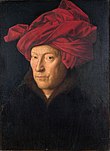Portrait of a Man with Carnation

Portrait of a Man with Carnation is a small oil on oakwood painting usually attributed to the Early Netherlandish master Jan van Eyck or a member of his workshop. Based on dendrochronological examination of the wood, it is thought to have been completed relatively late in van Eycks career, perhaps around 1436.[1] It is now in the Gemäldegalerie, Berlin. The sitter wears a large grey fur lined hat, and grey clothes, fur lined at the neck. holds a small bunch of carnations, symbols of marriage. He has not been identified, but wears the medal of the Order of Saint Anthony, established by Albert I, Duke of Bavaria. The man is older, probably in his early 50s, and has a coarse, rough look.[2]
Notes
Sources
- Ammann, Ruth. In The Enchantment of Gardens: A Psychological Approach. Daimon Verlag, 2009. ISBN 3-8563-0724-9
- Giltay, J. Review of "Hubert and Jan van Eyck" by Elisabeth Dhanens. Simiolus: Netherlands Quarterly for the History of Art, Volume 13, No. 1, 1983
- Borchert, Till-Holger. Van Eyck. London: Taschen, 2008. ISBN 3-8228-5687-8
- v
- t
- e
- Portrait of a Man with a Blue Chaperon c. 1430
- Léal Souvenir (1432)
- Portrait of Cardinal Niccolò Albergati (1432)
- Portrait of a Man (Self Portrait?) (1433)
- Arnolfini Portrait (1434)
- Portrait of Baudouin de Lannoy c. 1435
- Portrait of Jan de Leeuw (1436)
- Portrait of Giovanni di Nicolao Arnolfini c. 1438
- Portrait of Margaret van Eyck (1439)

works
- Annunciation (Madrid) c. 1432–1434
- Saint Francis Receiving the Stigmata c. 1432–1440
- Annunciation (Washington) c. 1434–1436
- Madonna of Chancellor Rolin (1435)
- Lucca Madonna (1436)
- Virgin and Child with Canon van der Paele (1436)
- Madonna in the Church c. 1438–1440
- Madonna at the Fountain (1439)
- Madonna of Jan Vos (1441–1443)
- Ghent Altarpiece (with Hubert van Eyck, completed 1432)
- Crucifixion and Last Judgement Diptych c. 1430–1440
- Dresden Triptych c. 1437
manuscripts
- Turin–Milan Hours ("Hand G", c. 1420)
- Saint Barbara (1437)
- Study for Cardinal Niccolò Albergati c. 1432
- Study for a Crucifixion c. 1440
- Portrait of Isabella of Portugal c. 1428–29
- Saint Christopher c. 1460
- Woman Bathing c. 1434
- Vera Icon (Head of Christ) (before 1438)
- Madonna of Nicolas van Maelbeke (after 1440)
- The Three Marys at the Tomb c. 1420s
- The Fountain of Life c. 1432
- Portrait of a Man with Carnation (1435)
- Crucifixion c. 1430–1432
- Ince Hall Madonna (after 1434)
- Christ on the Cross with the Virgin and Saint John c. 1435
- Saint Jerome in His Study (1442)
- Hubert van Eyck (brother)
 | This article about a fifteenth-century painting is a stub. You can help Wikipedia by expanding it. |
- v
- t
- e












